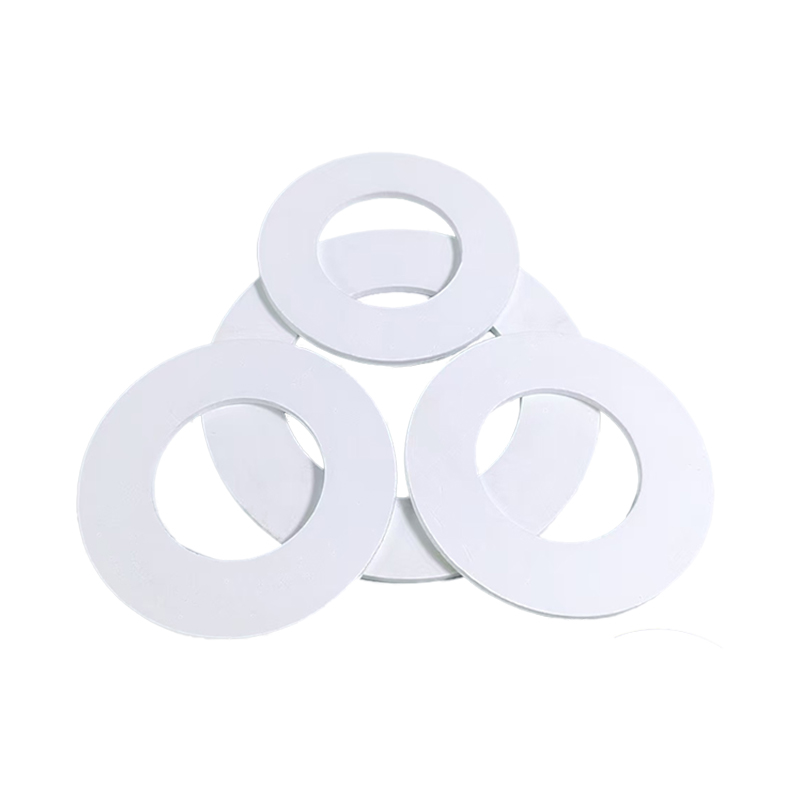
PRODUCTS
PTFE Gaskets
PTFE Gaskets offer exceptional chemical resistance and low friction, making them ideal for demanding applications. Crafted from high-quality PTFE, these gaskets withstand harsh chemicals and high temperatures while maintaining a reliable seal. Their smooth surface prevents contamination, ensuring purity in critical industries like chemical, pharmaceutical, and food processing. Designed for flexibility, they fit various flange sizes and shapes, providing a durable, low-maintenance, and cost-effective sealing solution.
PRODUCT DETAILS
PTFE (Polytetrafluoroethylene) Gaskets, commonly known as Teflon gaskets, are widely recognized for their exceptional sealing properties and versatility in various industrial applications. These gaskets are designed to provide a reliable seal under a broad range of temperatures and pressures, making them ideal for use in flanges, valves, and other piping systems where a tight seal is crucial.
1.Key Features of PTFE Gaskets
Chemical Resistance
PTFE gaskets are chemically inert and can resist a wide array of chemicals, including acids, bases, and solvents. This resistance makes them suitable for use in chemical processing, pharmaceuticals, and other industries where exposure to aggressive chemicals is common.
Temperature Stability
PTFE gaskets can operate effectively across a wide temperature range, typically from -268°C (-450°F) to 260°C (500°F). This broad temperature range ensures that they remain functional and reliable in both cryogenic and high-temperature environments.
Low Friction Coefficient
The low friction coefficient of PTFE makes these gaskets ideal for applications where reduced wear and tear are necessary. This property also facilitates easy installation and removal, reducing maintenance requirements.
High Pressure Resistance
PTFE gaskets are capable of withstanding high pressures, making them suitable for use in high-pressure systems such as those found in the oil and gas industry.
Non-Stick Surface
The non-stick surface of PTFE gaskets prevents adhesion of process materials, which is particularly beneficial in food processing and pharmaceutical applications where contamination must be avoided.
2.Applications of PTFE Gaskets
Chemical Processing
In chemical plants, PTFE gaskets are used in reactors, distillation columns, and storage tanks due to their excellent chemical resistance and temperature stability.
Pharmaceutical Industry
PTFE gaskets are used in equipment for drug manufacturing, ensuring that there is no contamination of the product due to their non-stick and chemically inert properties.
Food Processing
In the food industry, PTFE gaskets are used in processing equipment where they come into contact with food products, ensuring cleanliness and preventing cross-contamination.
Oil and Gas Industry
PTFE gaskets are used in high-pressure pipelines and valves, providing reliable sealing in harsh environments.
Automotive Industry
In automotive applications, PTFE gaskets are used in engine components and fuel systems, where they provide a tight seal and resist high temperatures and pressures.
3.Advantages of PTFE Gaskets
Enhanced Reliability
The combination of chemical resistance, temperature stability, and low friction makes PTFE gaskets a reliable choice for sealing applications.
Easy Maintenance
The non-stick surface and ease of installation make PTFE gaskets low maintenance, reducing downtime and maintenance costs.
Versatility
PTFE gaskets are suitable for a wide range of applications across various industries, making them a versatile sealing solution.
Cost-Effective
While initially more expensive than some other gasket materials, PTFE gaskets offer a cost-effective solution due to their long service life and reduced maintenance requirements.
4.Maximizing the Efficiency of PTFE Gaskets in Your Applications
Understanding PTFE Gasket Performance
To truly leverage the benefits of PTFE gaskets, it's crucial to understand how they perform under different conditions. PTFE gaskets are renowned for their ability to provide a tight seal in both static and dynamic applications. Their slip-resistant nature and high load-bearing capacity make them ideal for applications involving frequent movement or pressure fluctuations.
Compatibility Check
One of the first steps in utilizing PTFE gaskets effectively is ensuring compatibility with the materials and fluids they will come into contact with. PTFE's resistance to a broad spectrum of chemicals is one of its key advantages, but it's still important to verify that the gasket will not react with specific substances in your system, especially if you're working with aggressive or exotic chemicals.
Pressure and Temperature Assessment
Assessing the pressure and temperature conditions in your system is vital for selecting the appropriate PTFE gasket. While PTFE can handle a wide range of temperatures, extreme conditions may require special considerations or modifications to the gasket's design to ensure optimal performance and longevity.
Installation Practices
Proper installation is key to getting the most out of your PTFE gaskets. Ensure that the gasket is correctly positioned and that there is an even distribution of the compressive force across its surface. This helps prevent deformation and ensures a consistent seal. Using the appropriate tools and techniques during installation can also help avoid damage to the gasket, which could compromise its sealing effectiveness.
Maintenance and Inspection
Regular inspection and maintenance of PTFE gaskets can help extend their service life and prevent unexpected failures. Look for signs of wear, deformation, or chemical degradation during routine maintenance checks. Early detection of these issues allows for timely replacement or repair, minimizing downtime and maintenance costs.
Cost-Benefit Analysis
While PTFE gaskets may have a higher upfront cost compared to some other materials, their long service life, low maintenance requirements, and superior sealing performance often justify the investment. Conducting a cost-benefit analysis can help you determine if PTFE gaskets are the most economical choice for your specific application in the long run.
Customization for Specific Needs
Consider the possibility of customizing PTFE gaskets to meet the unique requirements of your application. Whether it's adjusting the thickness, density, or incorporating special features like reinforced edges or metal inserts, customization can enhance the gasket's performance and durability.
Conclusion
PTFE Gaskets offer a high-performance sealing solution for a wide range of industrial applications. Their chemical resistance, temperature stability, and low friction make them ideal for use in environments where reliability and longevity are crucial. By choosing the right PTFE gasket for your specific needs, you can ensure enhanced reliability, easy maintenance, and a versatile sealing solution that meets the demands of your applications.

